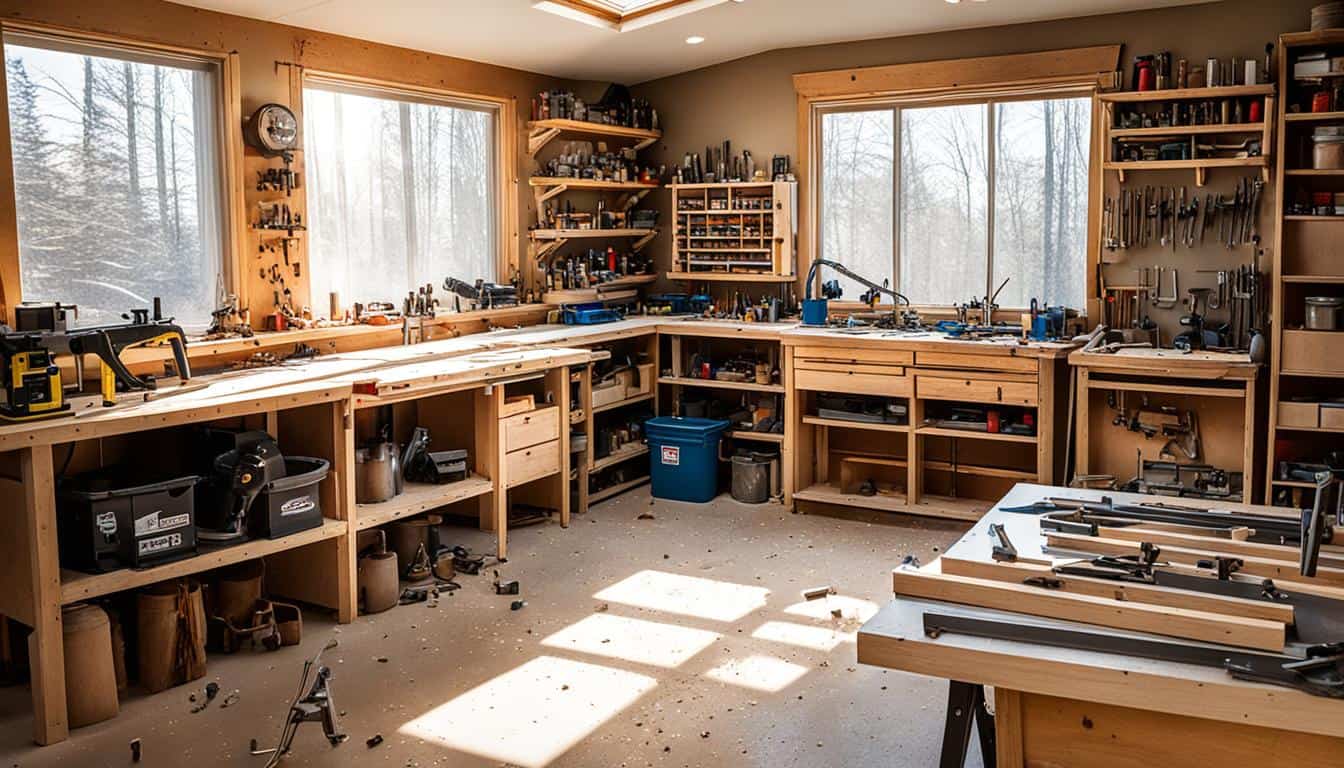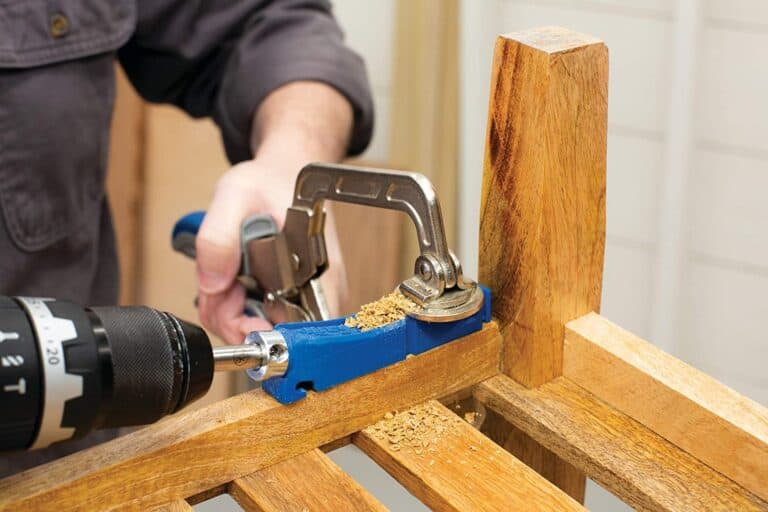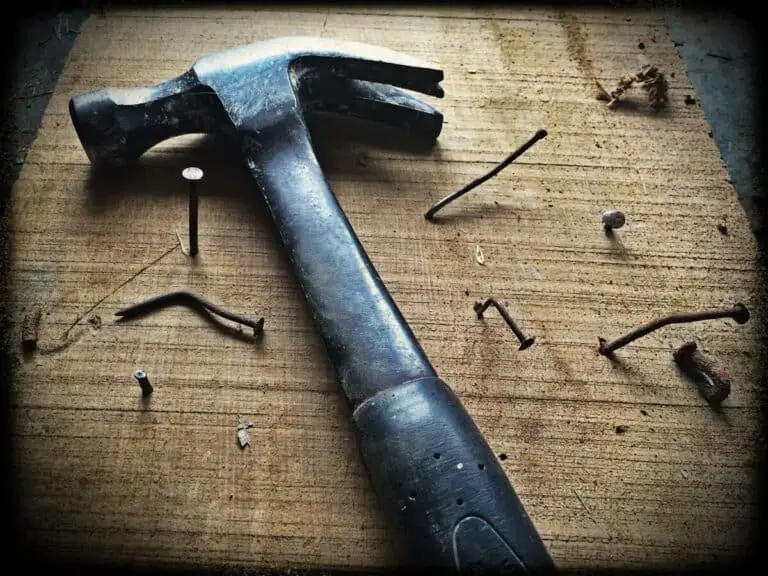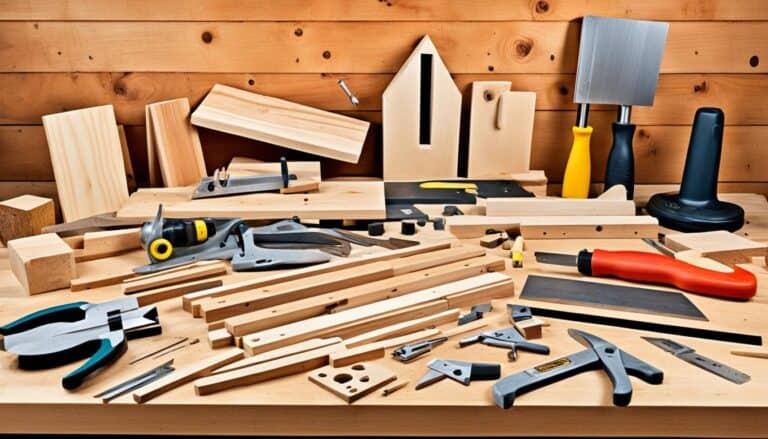Are you ready to unlock the full potential of your woodworking shop and achieve woodworking success? Whether you’re a seasoned woodworker or just starting out, this guide will provide you with all the tools, projects, classes, and techniques you need to create masterful pieces and take your woodworking skills to the next level.
Key Takeaways:
- Discover the importance of having the right tools in your woodworking shop
- Learn about the top 10 essential tools every woodworker should have
- Explore the versatility and importance of essential woodworking tools
- Get valuable tips for beginners using essential woodworking tools
- Find out how to choose the best quality versions of essential woodworking tools
The Importance of Having the Right Tools in Your Woodworking Shop
Having the right tools in your woodworking shop is crucial for the success of your projects. The tools you choose will not only affect the quality of your craftsmanship but also the efficiency of your work. Investing in high-quality woodworking tools that are specifically tailored to your needs can greatly enhance your overall woodworking experience.
Whether you are a seasoned professional or just starting out, having the right tools can make a significant difference in the outcome of your woodworking projects. With the right tools at your disposal, you can ensure precision, accuracy, and durability in your work. From hand tools like chisels and planes to power tools such as table saws and routers, each tool serves a specific purpose and contributes to the overall success of your woodworking endeavors.
“The tools you choose can make or break your woodworking projects. Investing in high-quality tools will not only save you time and frustration but also help you achieve professional-level results.”
Woodworking tools are designed to help you shape, cut, carve, and join wood with utmost precision. They allow you to bring your ideas to life and create beautiful, functional pieces. Without the right tools, you may struggle with inaccuracies, poor finishes, and overall dissatisfaction with your final products.
Woodworking tools come in a variety of forms, sizes, and functions. Some are essential for every woodworker’s shop, while others may be specific to certain projects or techniques. It’s important to understand the purpose of each tool and how it can contribute to your woodworking process.
By having the right tools in your woodworking shop, you can:
- Efficiently measure, mark, and layout your workpieces for precise cuts and joinery.
- Create clean and accurate cuts, whether it’s straight, curved, or angled.
- Smooth and shape wood surfaces to achieve desired finishes.
- Join wood securely and seamlessly, ensuring the structural integrity of your projects.
- Add decorative details and embellishments to elevate the aesthetic appeal of your creations.
Investing in high-quality tools will not only save you time and frustration but also help you achieve professional-level results. When choosing woodworking tools, consider factors such as durability, reliability, ergonomics, and the specific needs of your projects. By equipping yourself with the right tools, you can enhance your woodworking skills, expand your capabilities, and embark on a fulfilling journey of creativity and craftsmanship.
Top 10 Essential Tools Every Woodworker Should Have in Their Workshop
When it comes to woodworking, having the right tools in your workshop is essential. Whether you’re a beginner or an experienced woodworker, these top 10 tools will help you tackle various woodworking projects with ease and precision.
- Circular Saw: A versatile tool for making straight cuts and rough dimensioning.
- Power Drill: Essential for drilling holes and driving screws.
- Jigsaw: Perfect for intricate cuts and curves.
- Random Orbital Sander: Ensures smooth finishes on wood surfaces.
- Table Saw: Indispensable for accurate cuts and ripping lumber.
- Compound Miter Saw: Ideal for precise angle cuts.
- Router: Adds decorative details and creates intricate patterns.
- Chisels: Allows for detailed handwork and shaping wood.
- Clamps: Holds pieces firmly in place during assembly.
- Measuring and Marking Tools: Ensures accuracy and precision in your work.
With these essential tools in your woodworking shop, you’ll have the foundation to tackle a wide range of projects and achieve professional-level results. Remember to invest in high-quality tools that suit your needs and always prioritize safety when working with power tools.
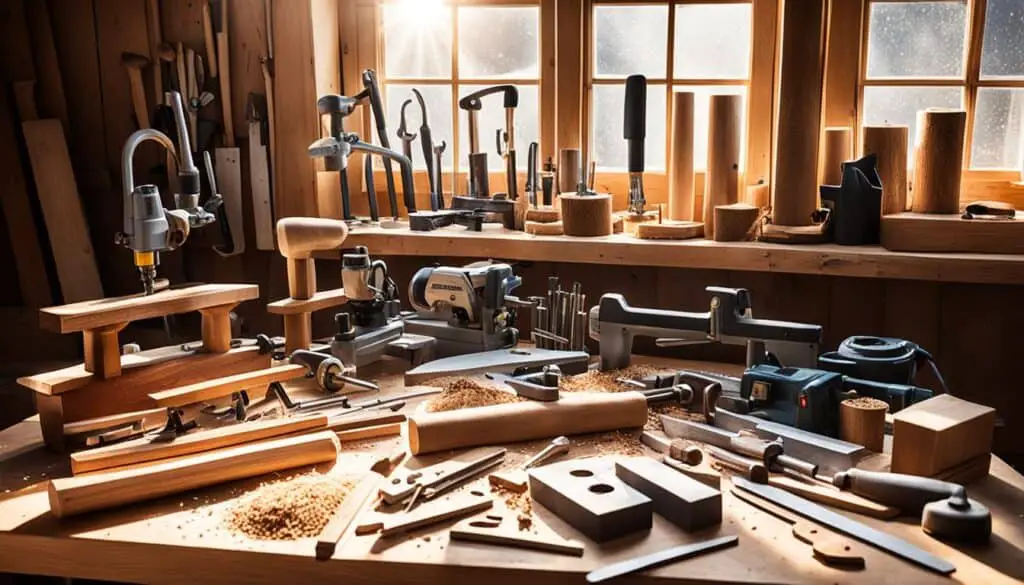
Choosing the Right Brands
When selecting your woodworking tools, it’s important to choose reliable brands known for their durability and performance. Research different brands, read customer reviews, and compare features to make informed decisions. Investing in high-quality tools will not only enhance your woodworking experience but also ensure the longevity of your tools.
The Versatility and Importance of Essential Woodworking Tools
When it comes to woodworking, having the right tools is essential for successful projects. Each essential woodworking tool serves a unique purpose, allowing you to create stunning pieces and bring your woodworking projects to life. Let’s explore the versatility and importance of these essential woodworking tools:
The Circular Saw
The circular saw is a true workhorse in any woodworking shop. With its ability to make straight cuts and rough dimensioning, it is a versatile tool that every woodworker needs. Whether you’re working with plywood, hardwood, or softwood, the circular saw ensures clean and precise cuts.
The Power Drill
The power drill is an indispensable tool in woodworking. It allows you to drill holes of various sizes and depths, as well as drive screws with ease. With the right drill bits and attachments, you can create pilot holes, counterbores, and countersinks, providing stability and precision in your woodworking projects.
The Jigsaw
For intricate cuts and curves, the jigsaw is the go-to tool. Its thin, narrow blade enables you to make intricate and detailed cuts, giving your woodworking projects a unique touch. Whether you’re cutting curves, shapes, or decorative patterns, the jigsaw offers unparalleled versatility.
The Random Orbital Sander
To achieve smooth and flawless finishes, the random orbital sander is a must-have tool. It combines the rotational motion of a disc sander with the orbital motion of an orbital sander, minimizing swirl marks and providing a consistent finish. From initial sanding to final polishing, the random orbital sander ensures professional-looking results.
The Table Saw and Compound Miter Saw
When it comes to making accurate cuts, the table saw and compound miter saw are indispensable. The table saw offers precision and control, allowing you to make straight cuts, rip boards, and create smooth edges. The compound miter saw, on the other hand, enables you to make precise angle cuts for joinery, molding, and trim work.
The Router
If you want to add decorative details and create intricate designs, the router is an essential tool. With a wide range of bits and accessories, you can shape edges, create grooves, carve patterns, and even make dovetail joints. The router opens up endless possibilities for customization and creativity in your woodworking projects.
Chisels and Clamps
Chisels are invaluable for detailed handwork and shaping. They allow you to carve, pare, and remove wood accurately, giving your projects fine details and clean lines. Clamps, on the other hand, hold your pieces together securely, ensuring stability and precision during assembly, gluing, and finishing.
Measuring and Marking Tools
Accuracy and precision are crucial in woodworking, and that’s where measuring and marking tools come in. Tape measures, rulers, squares, and marking gauges ensure that your cuts, joints, and dimensions are spot on, resulting in professional-looking pieces.
Having these essential woodworking tools in your workshop empowers you to take on a wide range of projects and explore various woodworking techniques. They enable you to work with precision, create intricate designs, and achieve outstanding results.
So, equip your woodworking shop with these versatile tools and unlock your woodworking potential.
| Woodworking Tool | Versatility | Importance |
|---|---|---|
| Circular Saw | Versatile for straight cuts and rough dimensioning | Essential for clean and precise cuts |
| Power Drill | Allows drilling holes and driving screws | Indispensable for woodworking projects |
| Jigsaw | Perfect for intricate cuts and curves | Provides unique design possibilities |
| Random Orbital Sander | Ensures smooth and flawless finishes | Produces professional-looking results |
| Table Saw and Compound Miter Saw | Indispensable for accurate cuts | Offers precision and control |
| Router | Adds decorative details and intricate designs | Unleashes creativity in woodworking projects |
| Chisels | Allows detailed handwork and shaping | Provides fine details and clean lines |
| Clamps | Holds pieces securely during assembly | Ensures stability and precision |
| Measuring and Marking Tools | Ensures accuracy and precision | Crucial for professional-looking pieces |
Tips for Beginners Using Essential Woodworking Tools
As a beginner in woodworking, using essential woodworking tools can feel daunting. However, with the right guidance and practice, you can effectively utilize these tools to create beautiful projects. To help you get started, here are some tips to keep in mind:
- Familiarize yourself with each tool: Take the time to understand the functions and features of each tool in your woodworking shop. Read the manuals, watch instructional videos, and study diagrams to gain a clear understanding of how to use them safely and effectively.
- Follow best practices: Safety should always be a top priority. Familiarize yourself with the recommended safety procedures for each tool, including wearing appropriate protective gear. Adhering to best practices will ensure that you work in a safe and efficient manner.
- Start with simple projects: Begin your woodworking journey by tackling simple projects that match your skill level. This will help you build confidence and develop your woodworking techniques. Start with basic cuts and gradually progress to more complex projects as you gain experience.
- Take advantage of online resources: There are countless online tutorials, classes, and workshops available that offer valuable guidance on woodworking techniques. Explore these resources to learn from experienced woodworkers and gain insights into best practices.
Remember, Rome wasn’t built in a day. Take your time to learn and practice, and don’t be discouraged by mistakes. Woodworking is a craft that rewards patience and perseverance.
By applying these tips, you’ll be well on your way to mastering the essential woodworking tools in your shop. Keep honing your skills, seek out inspiration, and don’t be afraid to experiment and push your creative boundaries.
Now, let’s delve into another critical aspect of woodworking – choosing the best quality versions of essential woodworking tools.

Choosing the Best Quality Versions of Essential Woodworking Tools
When it comes to woodworking, having the right tools is essential for achieving the best results in your projects. In this section, we will guide you on how to choose the best quality versions of essential woodworking tools. By considering factors such as quality, brand reliability, durability, and user reviews, you can make informed decisions and invest in tools that will enhance your woodworking experience.
Research Different Brands
Different brands offer a wide variety of woodworking tools, each with its own strengths and features. Take the time to research and compare the offerings from different brands. Look for brands with a reputation for quality and reliability in the woodworking community. Pay attention to the materials used, construction techniques, and overall craftsmanship of the tools.
Compare Features
Once you have narrowed down the brands that you are interested in, compare the features of their tools. Consider the specific needs of your woodworking projects and look for tools that provide the functionalities you require. Whether you need precise cutting, powerful performance, or versatile functions, choose tools that align with your woodworking goals.
Read Customer Feedback
One of the best ways to gauge the quality and performance of woodworking tools is by reading customer feedback. Look for online reviews, forums, or social media groups where woodworkers discuss their experiences with different tools. Pay attention to the overall satisfaction of customers and any common issues or praises mentioned. This feedback can provide valuable insights into the performance and durability of the tools you are considering.
Invest in Quality
Remember, when it comes to woodworking tools, it is worth investing in quality. High-quality tools not only last longer but also offer better precision, reliability, and overall performance. While they may come with a higher price tag initially, the long-term benefits and the satisfaction you will experience in your woodworking projects make it a worthwhile investment.
| Brand | Features | User Ratings |
|---|---|---|
| Brand A | High-quality materials, ergonomic design, range of functions | 4.5/5 |
| Brand B | Excellent performance, durability, industry-leading innovations | 4.7/5 |
| Brand C | Precision engineering, versatility, trusted by professionals | 4.3/5 |
In conclusion, choosing the best quality versions of essential woodworking tools requires careful consideration of factors such as quality, brand reliability, durability, and user feedback. By doing your research, comparing features, and investing in high-quality tools, you can ensure that your woodworking experience is enhanced and your projects achieve the best results.
Dust Collection and Shop Size for Woodworking Success
Dust collection is crucial in your woodworking shop to ensure both the health and safety of your workspace. When working with wood, airborne dust particles can be generated, which can lead to respiratory issues and pose a risk to your well-being. To maintain a clean and safe environment, it is essential to set up an effective dust collection system.
A proper dust collection system typically consists of central ducts and flexible tubing that leads to a central dust collector. This system helps prevent airborne dust by capturing it at the source and directing it away from the work area. By effectively collecting the dust, you not only create a healthier work environment, but you also reduce the risk of dust-related accidents.
You can enhance the efficiency of your dust collection system by considering the size of your woodworking shop. The size of your shop plays a significant role in determining the dust collection capacity and layout. A larger shop may require a more robust collection system with greater suction power to effectively capture the dust. On the other hand, a smaller shop may benefit from a more compact system that balances space efficiency with adequate dust collection capabilities.
By investing in a proper dust collection system and considering the size of your woodworking shop, you can create a cleaner and safer workspace, allowing you to focus on your craft with peace of mind.
Benefits of Dust Collection in Your Woodworking Shop
Implementing a dust collection system in your woodworking shop offers several benefits:
- Promotes better respiratory health by minimizing airborne dust particles
- Reduces the risk of accidents and fire hazards caused by combustible dust
- Maintains a clean and organized work environment
- Protects the longevity and efficiency of your woodworking tools and machinery
- Improves visibility and accuracy during woodworking operations
Dust Collection System Components
A typical dust collection system consists of the following components:
| Component | Description |
|---|---|
| Central Dust Collector | A powerful unit that captures and collects dust particles through the central ductwork system |
| Central Ductwork System | Consists of rigid or flexible tubing that connects the individual dust collection points to the central dust collector |
| Blast Gates | Allows for individual control of dust collection points, enabling you to concentrate suction where needed |
| Dust Collection Hood | Used to capture dust at the source, such as at the blade or cutter on machinery |
| Dust Separator | Prevents larger debris from reaching the dust collector, improving its efficiency and reducing maintenance |
These components work together to create an efficient and effective dust collection system for your woodworking shop, ensuring a cleaner and safer environment.
Workshop Electrical Considerations for Woodworkers
When setting up your woodworking shop, it’s crucial to consider the electrical aspects for both safety and efficiency. A well-planned electrical system can ensure that your tools are powered properly, minimizing the risk of electrical hazards and maximizing your productivity. Here are some key workshop electrical considerations for woodworkers:
Dedicated Electrical Sub-Panel
Installing a dedicated electrical sub-panel for your woodworking shop is highly recommended. This sub-panel will handle the power requirements of your woodworking equipment, preventing overloading your main electrical panel. With a dedicated sub-panel, you can easily control and monitor the electrical supply to your woodworking shop.
Conveniently Positioned Outlets
Position electrical outlets at a convenient height in your woodworking shop. This makes it easier to plug in your tools without having to bend down or stretch cords across your workspace. Consider the layout of your shop and the placement of your workbenches and machinery to determine the optimal positioning for your outlets.
220V Circuits for Heavy-Duty Machinery
For heavy-duty woodworking machinery, such as table saws and planers, consider installing dedicated 220V circuits. These circuits provide the necessary power for running large equipment efficiently and prevent electrical issues that can arise from operating high-power devices on standard 110V circuits. Consult a qualified electrician to ensure the circuits are properly installed and compatible with your machinery.
Proper Lighting for Visibility and Precision
Good lighting is essential in a woodworking shop for visibility and precision in your work. Utilize a combination of natural and artificial lighting sources to create a well-lit environment. Natural light can be enhanced with strategically placed windows or skylights, while artificial lighting can be achieved through overhead fixtures and task lights near work areas. Adequate lighting will help you see your work clearly and prevent accidents.
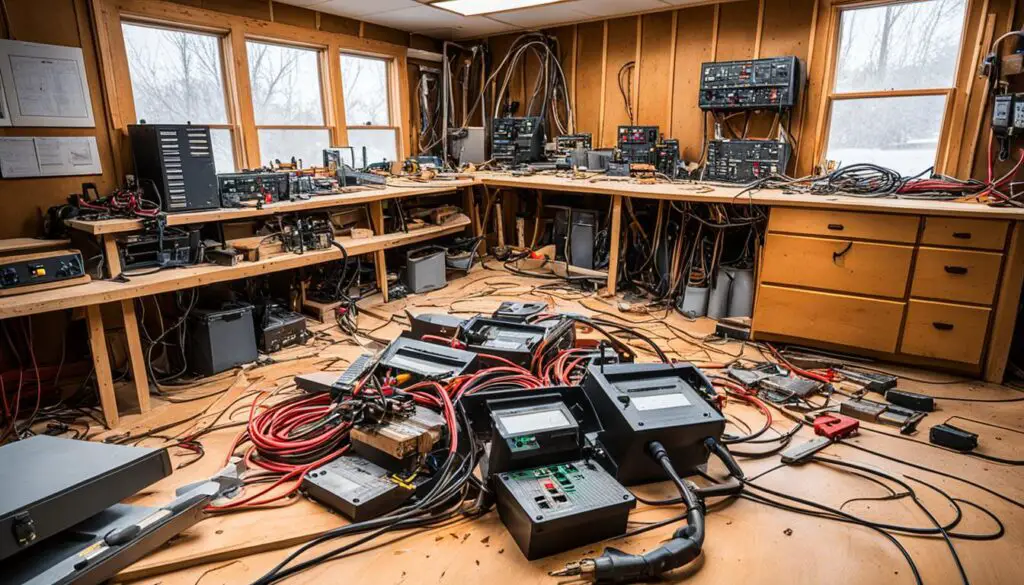
By considering these electrical aspects in your woodworking shop, you can create a safe and efficient workspace. Remember to consult a licensed electrician for professional guidance and ensure that all electrical work is done to code. With a well-planned electrical setup, you can focus on your woodworking projects with peace of mind.
Shop Size and Layout for Optimal Workflow
The size and layout of your woodworking shop can greatly impact your workflow and productivity. It’s essential to create a space that maximizes efficiency and allows for seamless movement between workbenches and machines. Considering the following factors will help you design a woodworking shop that enhances your craft:
Shop Size
When determining the size of your woodworking shop, it’s important to strike a balance between available space and functionality. While the minimum recommended area is 75 square feet, aiming for 125 square feet or more will provide ample room to work comfortably and store your tools and materials.
By having sufficient space, you can avoid overcrowding and promote a safer working environment. This allows you to move freely, access your equipment without obstacles, and organize your shop effectively. Remember to consider future expansions or additions to your shop as well.
Shop Layout
A well-designed shop layout ensures optimal workflow and minimizes unnecessary movement. Here are some key considerations:
- Carefully plan the placement of your workbenches and machines according to the workflow of your typical projects. Keep similar processes together to reduce time wasted on moving between different areas of the shop.
- Ensure there is enough clearance around doorways and between workstations to maneuver materials and large projects easily.
- Strategically position your tools and machinery to minimize clutter and create a smooth flow from one task to another. This will save you time and energy during project execution.
- Don’t forget to prioritize safety by maintaining adequate space around each machine for safe operation and easy maintenance.
Proper lighting is vital to enhance visibility and accuracy in your woodworking projects. Utilize a combination of natural light and artificial lighting sources to ensure you have adequate brightness in every corner of your shop.
Additionally, have dedicated storage solutions for your tools, materials, and project supplies. This will help you maintain an organized and clutter-free workspace, improving efficiency and reducing the chances of accidents or misplaced items.
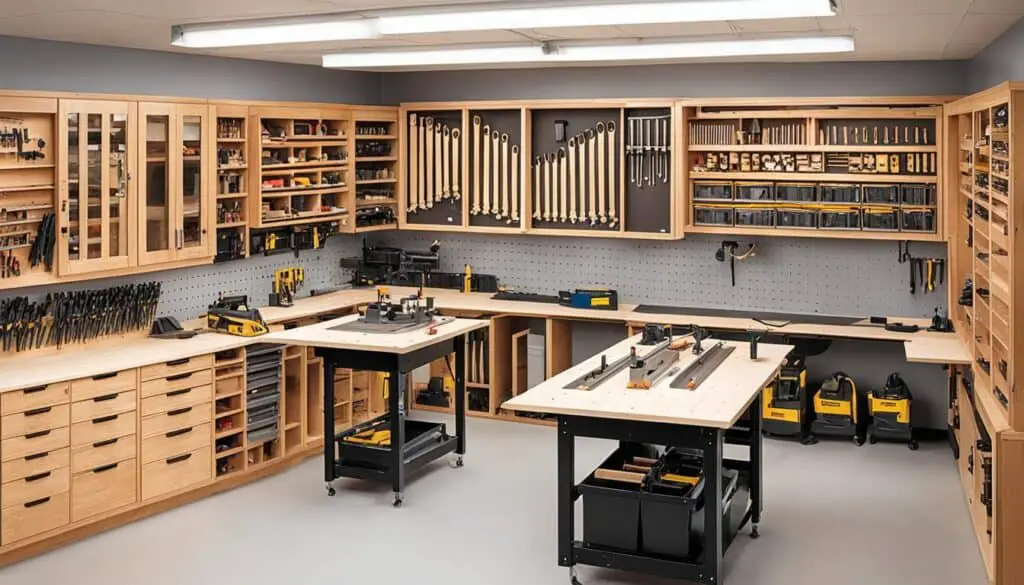
Creating a functional woodworking shop with a well-planned layout and ample space will allow you to work comfortably, efficiently, and safely. Investing time in designing and organizing your shop will pay off in the long run, helping you achieve woodworking success.
Making a Living from Woodworking: Challenges and Tips
Making a living from your woodworking shop and turning your passion into a profitable business is an achievable goal. However, it’s important to acknowledge that running a woodworking business involves more than just your woodworking skills. To succeed, you need to excel in various aspects of business management, including customer service, marketing, accounting, and pricing. Here are some key challenges you may face and tips to help you navigate them:
Understanding Costs and Covering Expenses
One of the first challenges you’ll encounter is understanding your costs and ensuring that your pricing covers all your expenses. Beyond the cost of materials, consider other overhead expenses such as rent, utilities, and equipment maintenance. Additionally, factor in your labor costs, including the time spent on each project, overhead hours, and non-billable tasks such as project planning and administrative work.
By accurately assessing your costs and setting appropriate pricing, you can ensure that your business remains sustainable and profitable in the long run.
Filtering Customers and Projects
Not every customer or project will align with your business goals or be financially viable. It’s essential to filter and assess potential customers and projects based on factors such as profitability, complexity, and compatibility with your skills and timeline.
Focus on attracting and retaining customers who appreciate your craftsmanship, understand the value you provide, and are willing to pay for quality work. By targeting the right customers, you can cultivate a loyal customer base, receive positive referrals, and increase your woodworking income.
Charging Appropriately for Your Time and Expertise
One common challenge for woodworking businesses is undervaluing their time and expertise. It’s important to set prices that reflect the value of your craftsmanship, skills, and experience. Consider not only the time spent on each project but also the years of practice and investment you’ve made in your woodworking shop.
While competitive pricing is important, avoid the temptation to undercharge in an attempt to win every project. Properly pricing your work allows you to cover costs, generate a sustainable income, and invest in the growth of your woodworking business.
Continued Learning and Skill Development
To stay competitive in the woodworking industry and overcome challenges, it’s crucial to continue learning and developing your skills. Attend woodworking workshops, take online courses, and stay updated with the latest techniques, trends, and tools. Embrace opportunities for professional growth and refine your craft to deliver exceptional results that set you apart from others in the market.
Remember, your woodworking journey is a continuous process of growth and improvement. By honing your skills and staying up-to-date, you can elevate the quality of your work, attract more customers, and increase your woodworking income.
No matter the challenges you face, perseverance, determination, and adapting to evolving market demands will contribute to your success as a woodworking business owner. With the right strategies, dedication to your craft, and a strong focus on your customers, you can build a thriving woodworking business and turn your passion into a sustainable source of income.
Pricing, Quoting, and Profitability in Woodworking Business
Pricing your woodworking projects accurately is essential for the profitability and success of your woodworking business. It requires careful consideration of various factors to ensure that you cover all costs and generate a fair profit. By following these key practices, you can establish a pricing strategy that aligns with your goals and maximizes your profitability.
Understanding Your Costs
Before setting your prices, it’s crucial to have a clear understanding of all costs associated with your woodworking projects. These costs include:
- Materials: Calculate the cost of the raw materials used for each project, including wood, hardware, finishes, and other supplies.
- Labor: Determine the amount of time you spend on each project and assign an appropriate hourly rate to account for your expertise and skill.
- Non-billable Tasks: Consider the time and effort spent on non-billable tasks such as project planning, sourcing materials, and administrative work.
- Holidays and Time Off: Account for holidays, weekends, and vacation time when estimating your annual revenue and hourly rate.
- Take-home Wage: Ensure that your pricing allows for a reasonable take-home wage that covers your living expenses.
- Taxes: Factor in taxes and any additional business expenses such as insurance, licenses, and permits.
- Profit: Set a profit margin that reflects the value of your work and contributes to the growth and stability of your business.
Tracking Hours and Expenses
To accurately assess the profitability of each project, it’s essential to track your hours and expenses. Keep a detailed record of the time spent on each phase of the project, including design, fabrication, finishing, and installation. Additionally, document all expenses related to materials, tools, and subcontractor services. By consistently monitoring your time and expenses, you can identify areas where costs can be reduced or efficiencies can be improved.
Reviewing Profitability
Regularly reviewing the profitability of each project is crucial for making informed business decisions. Analyze the actual time spent on each project compared to the estimated time and evaluate whether the pricing accurately reflects the effort involved. Consider the overall profitability of your woodworking business and identify ways to increase profits, such as streamlining processes, optimizing material usage, and targeting higher-paying projects.
“By understanding your costs, tracking hours and expenses, and reviewing each project’s profitability, you can make informed pricing decisions that drive the financial success of your woodworking business.”
Avoiding Free Quotations and Valuing Your Time and Expertise
As a woodworking professional, it’s important to avoid providing free quotations for your services. Your time and expertise are valuable, and providing free quotes can undermine the profitability of your business. Instead, establish a clear pricing structure and charge a fee for quotations. This ensures that potential clients value your time and expertise and filters out customers who may not be willing to invest in quality craftsmanship.
Saying No to Unprofitable Jobs
Not every job will align with your pricing or profitability goals, and it’s essential to be confident in saying no to unprofitable projects. While it can be tempting to take on every opportunity, it’s important to evaluate each job’s financial viability and consider the long-term impact on your business. Focus on projects that align with your pricing structure and offer the potential for profitability and growth.
“Don’t be afraid to say no to jobs that don’t align with your pricing or profitability goals. By focusing on profitable projects, you can ensure the long-term success of your woodworking business.”
Pricing, quoting, and profitability are crucial considerations in running a successful woodworking business. By understanding your costs, tracking hours and expenses, and valuing your time and expertise, you can establish a pricing strategy that supports profitability and growth. Don’t hesitate to say no to unprofitable jobs and focus on projects that align with your financial goals.
Building a Successful Woodworking Business: Strategies and Tips
Building a successful woodworking business requires a combination of honing your woodworking skills and developing strong business acumen. By implementing the following strategies and tips, you can enhance your chances of achieving growth and success in your woodworking shop.
1. Refine Your Making Process
Continuously refine your making process to maximize efficiency and productivity. Identify areas that can be improved, such as streamlining workflows, optimizing tool usage, or implementing time-saving techniques. Constantly seek ways to enhance the quality of your craftsmanship while minimizing wasted time and resources.
2. Invest in Efficient Tools
Investing in high-quality tools that improve efficiency and accuracy can significantly impact the success of your woodworking business. Upgrading to advanced power tools, ergonomic hand tools, or digital measuring devices can enhance your productivity and the quality of your finished products.
3. Specialize or Diversify as Needed
Consider specializing in a particular niche within the woodworking industry to differentiate yourself from competitors. Specialization allows you to develop expertise and cater to a specific target audience. Alternatively, diversifying your offerings can attract a broader customer base and create additional revenue streams.
4. Focus on Marketing
Develop a comprehensive marketing strategy to promote your woodworking business effectively. Create a professional website that showcases your portfolio, shares information about your services, and provides a way for potential customers to contact you. Utilize social media platforms, online directories, and local advertising to expand your reach and attract new customers.
5. Build Relationships with Designers and Architects
Establish strong relationships with local interior designers and architects who frequently require custom woodworking for their projects. Reach out to them, introduce your services, and showcase your expertise. Collaborating with professionals in the design industry can lead to valuable referrals and ongoing partnerships.
6. Utilize Technology for Lead Generation
Explore digital tools and technologies that can assist in lead generation and customer relationship management. Implement a customer relationship management (CRM) system to track leads, communicate effectively, and nurture relationships. Leverage email marketing campaigns and online advertising to generate leads and stay connected with your target audience.
7. Streamline Administrative Tasks
Manage your administrative tasks efficiently to free up more time for woodworking. Utilize productivity tools and software to automate invoicing, inventory management, and other administrative processes. By reducing the time spent on non-essential tasks, you can focus more on growing your woodworking business.
8. Stay Focused on Your Goals
Set clear goals for your woodworking business and stay focused on achieving them. Regularly reassess your progress, make adjustments as necessary, and stay motivated to overcome any obstacles that come your way. Consistent effort and determination are key to long-term success.
9. Adapt to Market Conditions
Monitor market trends and adapt your offerings to meet changing customer demands and preferences. Stay updated on industry developments, emerging technologies, and design trends. By proactively adjusting your business strategies, you can position yourself for sustained growth and relevance in the woodworking industry.
10. Invest in the Growth and Improvement of Your Business
Allocate resources to invest in the growth and improvement of your woodworking business. This can include attending woodworking trade shows, workshops, and training programs to expand your knowledge and skills. Continuously seek opportunities for personal and professional development that will positively impact your business in the long run.
By implementing these strategies and tips, you can build a successful woodworking business that thrives in competitive markets. Remember to continuously refine your woodworking skills, prioritize efficient business practices, and foster strong relationships with customers and industry professionals. With dedication and perseverance, your woodworking business can achieve sustainable growth and long-term success.
Conclusion
Building a successful woodworking shop and business requires a combination of woodworking skill, business acumen, and dedication. By understanding the importance of tools, techniques, pricing, customer filtering, and business operations, you can craft success in the woodworking industry.
Remember to continuously learn, adapt, and refine your skills, and always strive for excellence in your craftsmanship and customer service. With the right mindset, tools, and strategies, you can unlock the full potential of your woodworking shop and achieve woodworking success.
Whether you are just starting or have been in the woodworking business for years, never stop improving. Explore new techniques, invest in quality tools, and stay updated on industry trends. Embrace challenges and seize opportunities to grow your woodworking business. With determination and a passion for woodworking, you can establish a thriving business and make a name for yourself in the industry.
FAQ
What are some essential tools every woodworker should have in their workshop?
The top 10 essential tools every woodworker should have are the circular saw, power drill, jigsaw, random orbital sander, table saw, compound miter saw, router, chisels, clamps, and measuring and marking tools.
How can I use essential woodworking tools effectively as a beginner?
To use essential woodworking tools effectively as a beginner, familiarize yourself with each tool’s functions and safety features, follow best practices, and start with simple projects to build your skills. Online tutorials, classes, and workshops can also provide guidance and confidence.
What factors should I consider when selecting essential woodworking tools?
When selecting essential woodworking tools, consider factors such as quality, brand reliability, durability, and user reviews. Investing in high-quality tools that will last and perform well is important for a positive woodworking experience.
Why is dust collection important in a woodworking shop?
Dust collection is important in a woodworking shop for both health and safety reasons. Airborne dust generated during woodworking can lead to respiratory issues. Proper dust collection systems help prevent airborne dust and maintain a clean and safe shop environment.
How should I ensure adequate electrical service and lighting in my woodworking shop?
To ensure adequate electrical service and lighting, consider installing a dedicated electrical sub-panel to handle the power requirements of your woodworking equipment. Have electrical outlets positioned at a convenient height and consider dedicated 220V circuits for heavy-duty machinery. Proper lighting is crucial for visibility and precision in your work.
What should I consider when designing the size and layout of my woodworking shop?
When designing the size and layout of your woodworking shop, consider the minimum recommended area, optimize the flow between workbenches and machines, ensure clearance for doorways and movement of materials, and provide proper lighting and storage for tools and materials.
How can I make a living from woodworking?
Making a living from woodworking involves more than just woodworking skills. Prioritize business aspects such as customer service, marketing, accounting, and pricing. Understand costs, filter customers, and charge appropriately for your time and expertise to build a successful woodworking business.
What factors should I consider when pricing my woodworking projects?
When pricing your woodworking projects, consider all costs including materials, labor, non-billable tasks, holidays, take-home wage, taxes, and profit. Understanding costs, tracking hours and expenses, and reviewing job profitability are essential for long-term success.
How can I build a successful woodworking business?
To build a successful woodworking business, continuously improve your woodworking and business skills, refine your making process, invest in tools that increase efficiency, specialize or diversify as needed, focus your marketing efforts, have a professional website, build relationships with local designers and architects, use technology for lead generation, and prioritize growth and improvement.
How can I unlock the full potential of my woodworking shop?
To unlock the full potential of your woodworking shop, understand the importance of tools, techniques, pricing, customer filtering, and business operations. Continuously learn, adapt, and refine your skills, strive for excellence in your craftsmanship and customer service, and invest in the growth and improvement of your business.


